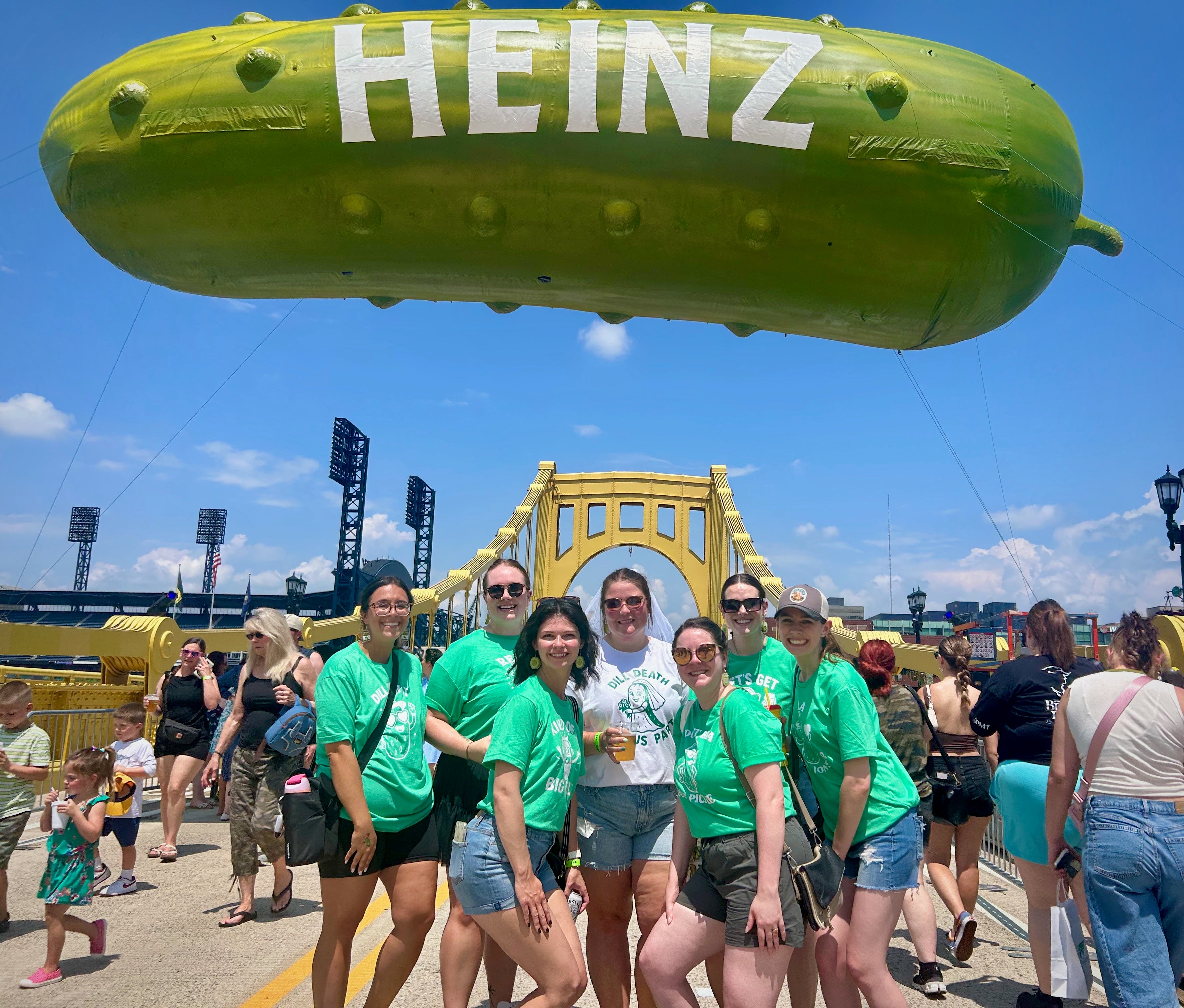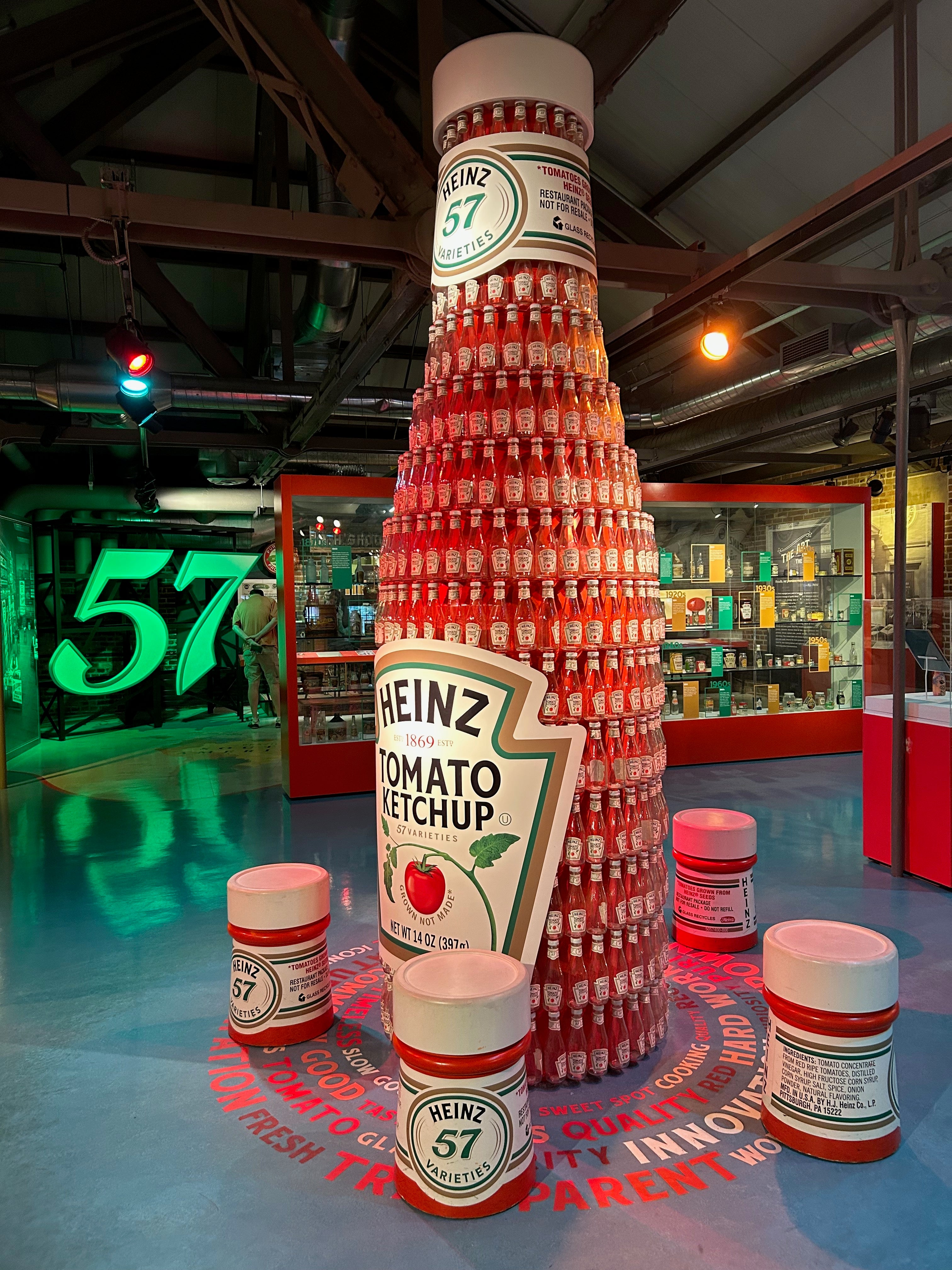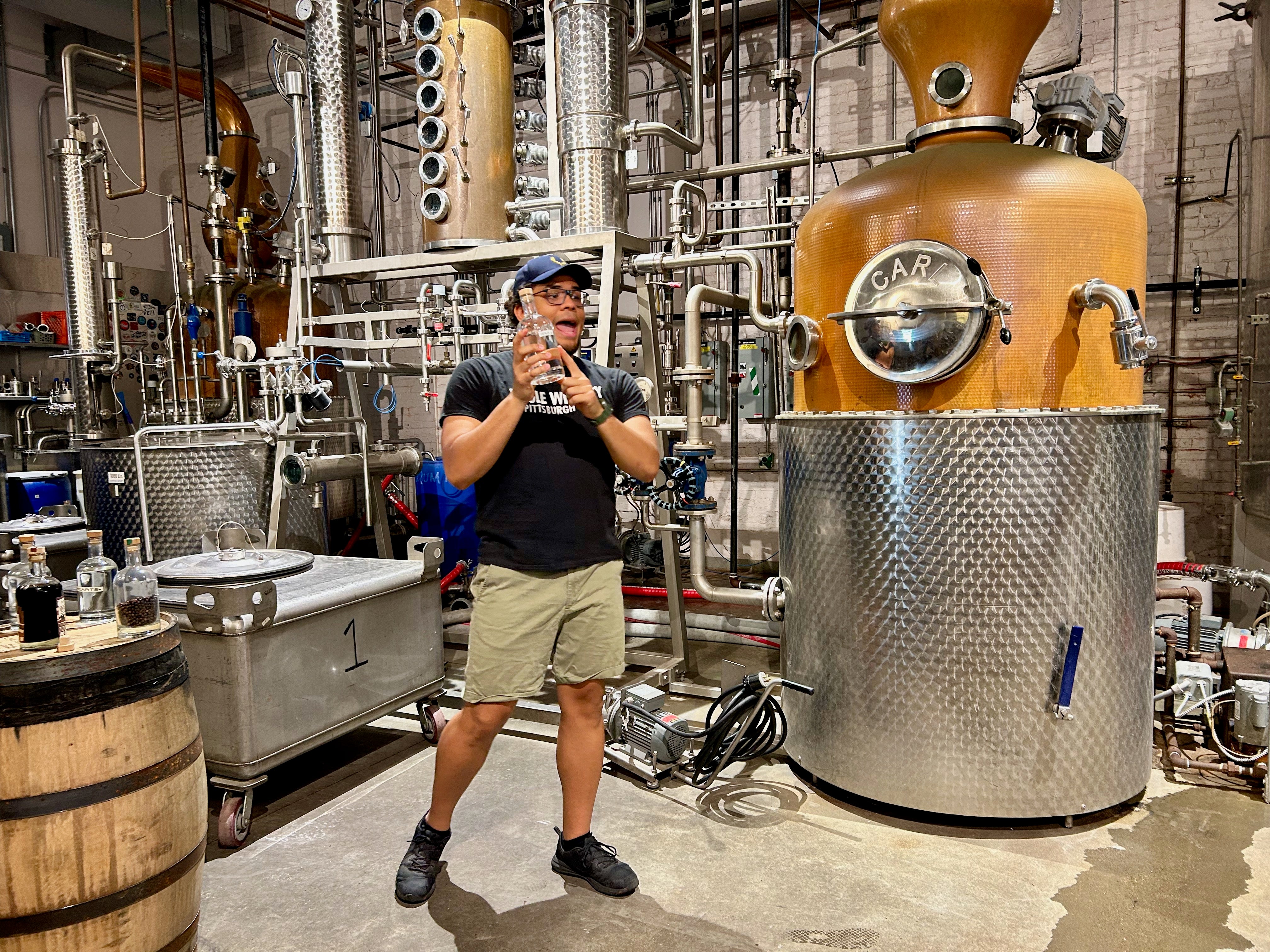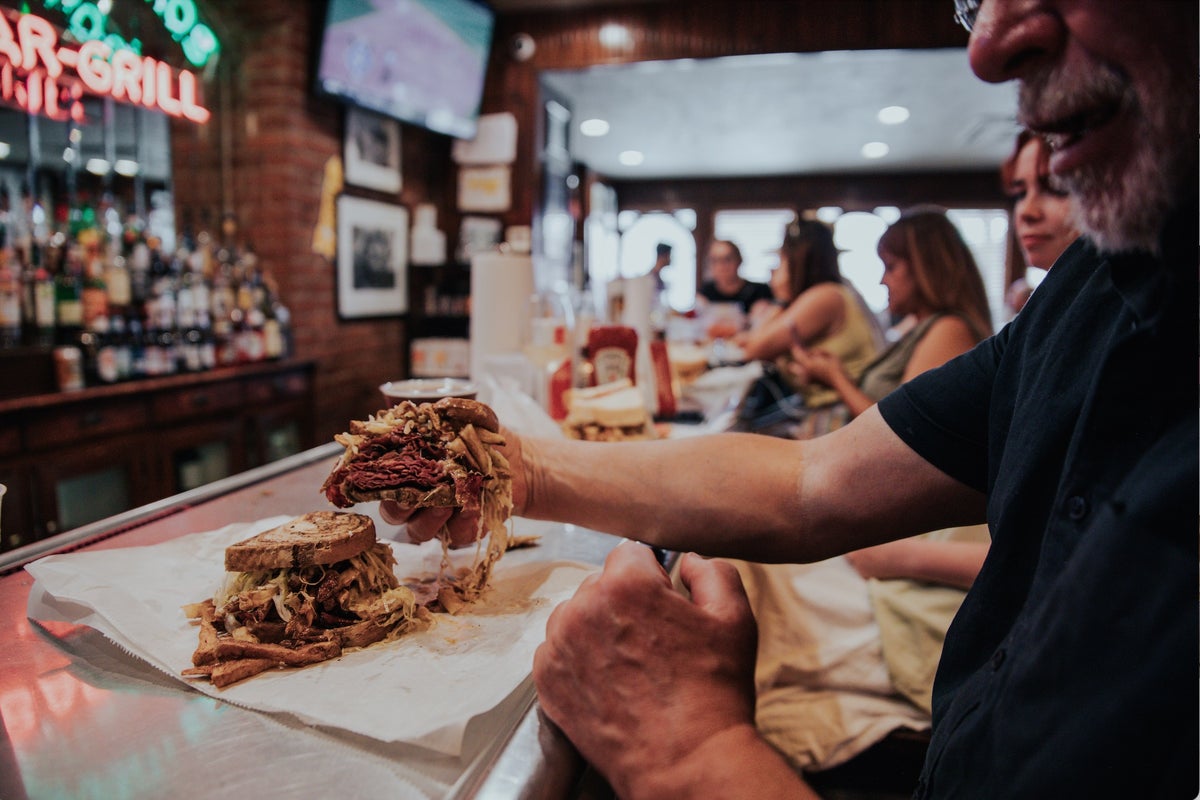It’s my dream to be mayor of Picklesburg,” declares Mason, whipping the crowd into a cheering frenzy. He looks confident, unlike the other 10 contestants nervously eyeing their one-litre jars of pickle juice, wondering what they’ve signed up for. As the crowd finishes counting down, Mason raises his jar and downs the juice in just eight seconds. The crowd gasps, while I almost gag. It’s a hot, humid day in Pittsburgh, but even I’m not that thirsty.
Celebrating its 10th year, Picklesburg is America’s top speciality food festival with more than 250,000 visitors. Laughter flows over chilled pickle beer and lemonade, with animated debates taking place about whether to try dill-stuffed pretzels, pickle pizza or candy floss, as a woman screams from the back of a pickle-shaped bucking bronco.
Feeling bemused by the sea of pickle T-shirts, hats and costumes, I ask Lauren, dressed as “Birthday Pickle”, what the fuss is about. “Pickles are just fun, you can do so much with them – beer, juice, snacks.” Another fan enthusiastically interrupts: “They’re salty, soft with a crunchy shell and just taste sooo good.” I’m not convinced, nor brave enough, to take them at their word. After all, there is more to Pittsburgh than its beloved pickle.

Once a gritty steel town, Pittsburgh has quietly transformed itself into a food-lovers’ city, where family-run restaurants are the beating heart of its 90 neighbourhoods. On a city break, I’m learning how its food scene is still rooted in its Eastern European, German and Italian immigrants, many of whom flocked there in the 19th century to work in factories.
Read more: Forget New York or Chicago – the best North American city is in Canada
I delve right into the central neighbourhood of Lawrenceville, strolling down quiet Butler Street where maple and cherry blossom trees frame Victorian-era buildings. Today, it’s full of independent shops and restaurants, but my guide Marla Rzeszotarski from ‘Burgh, Bits & Bites Food Tours tells me that only a decade ago, “it was a dangerous part of the city”. Lawrenceville has since reinvented itself and is now one of the city’s hippest neighbourhoods.
What strikes me most over the next two hours is the sheer variety of food packed into just a few small blocks – and not a single pickle in sight. Marla boasts: “You can get something like Frankie’s, which has been around for 80 years, or try a dish from a James Beard-nominated chef.”

At Frankie’s, a retro diner frozen in time with red leather booths and Formica tables, Marla hands us a pillowy white roll filled with soft onions and a smoky, garlic-spiced sausage that makes my taste buds tingle. Only a few doors down at the elegant Senti restaurant, we’re served melt-in-your-mouth, seven-layer lasagne, while admiring a state-of-the-art, automated wine dispenser. Marla feeds our brains with stories of Pittsburgh, while we feed our stomachs with everything from Lebanese shawarma to lavender mochas and homemade ice cream named after local golf legend Arnold Palmer.
Read more: How New York’s immigrant communities built a culinary capital
With this culinary spectrum on offer, I wonder if there’s a food that defines Pittsburgh, and without hesitation Marla tells me it’s the Primanti Bros. sandwich. A thick pastrami or corned beef sandwich, piled high with French fries and tangy coleslaw, all wrapped in newspaper so warehouse workers could eat it on the go. They’re still popular today, especially as a pre-game ritual for Pirates baseball or Steelers football games. I try one later from their flagship restaurant in the Strip District and, given the generous filling, I make a complete mess.
“It’s not the only Pittsburgh staple,” says Marla. “Because of our Eastern European roots, the food that always brings me back to Pittsburgh is its pierogies.” A soft Polish dumpling filled with creamy potatoes and cheese, “the best ones are usually handmade by church ladies in their eighties”. Trying a grandmother’s traditional recipe stocked in a local deli, I sink my teeth in and it feels like a comfort food wrapped in the city’s heritage.

As the tour comes to an end, Marla finishes by telling me that “people don’t know Pittsburgh for our food, so restaurants cater to locals more than visitors, and when I travel I really miss my neighbourhood restaurants”.
A little further down the Strip District, inside the Heinz History Center, I mischievously wonder what would happen if I touched the towering display of Heinz ketchup bottles, stacked into the shape of a giant bottle. Henry J Heinz, the son of German immigrants, launched his business in Pittsburgh, initially bottling horseradish in glass jars, then expanding to vinegar and pickles. He rapidly grew the Heinz brand, handing out more than a million pickle badges at the 1893 Chicago World’s Fair and coining the iconic “57 varieties” slogan, using his and his wife’s lucky numbers, rather than the number of Heinz products available. Wandering past vintage octagonal glass bottles of ketchup and cream of chicken soup tins, it seems that Pittsburgh has been stocking my kitchen cupboards for decades.
Read more: The best hotels in Los Angeles
Across the river, I go in search of another Pittsburgh native who elevated the everyday, Andy Warhol, transforming Campbell’s soup cans and Heinz ketchup bottles into pop art icons. As the largest American museum dedicated to a single artist, I marvel at his most famous works, as well as items from his personal archive, like his black leather boots and his rust-coloured, velvet sofa. It feels like both Heinz and Warhol capture the essence of Pittsburgh, a city where working-class roots are reimagined through innovative business and creativity; one through food, the other through art.
Back in the Strip District, among the city’s 40 craft breweries, another local name is reviving Pittsburgh’s heritage, in the form of rye whiskey. On a distillery tour to Wigle Whiskey, my guide, Braxton, explains: “Pennsylvania used to make nearly 70 per cent of the nation’s rye whiskey, but now we don’t even produce a percentage.” Over the cinnamon and cherry aromas from the Pennsylvania Straight Rye, I learn how German immigrant Philip Wigle distilled rye whiskey because it was far easier to transport barrels than haul tons of grain to market. However, Wigle’s name is synonymous with local resistance because of the key role he played in the Whiskey Rebellion in 1791. Refusing to pay the new taxes on distilled spirits, his act of defiance almost cost him his life.

Read more: Inside America’s budget-friendly, BBQ-obsessed World Cup city
The distillery keeps Wigle’s rebellious spirit alive, not just in telling his story, but in its quirkier creations like Eau de Pickle. The taste sparks laughter across the tour group and talk of Picklesburgh, where local resident Gina assures me: “Even if you don’t like pickles, you just get caught up in the atmosphere.” I couldn’t agree more as I wander back across the Andy Warhol Bridge, pickle badge on my green dress, ready to rejoin the city’s most eccentric celebration.
I shouldn’t have been surprised to run into bride-to-be Molly, dressed with a bridal veil and T-shirt that reads “dill death dill us part”. Having travelled more than one thousand miles for her hen party at Picklesburgh, she confesses “not all my friends love pickles”, and laughs, “we all agreed this was just too much fun to miss”. Like Marmite, pickles seem to spark a love-hate relationship, which only adds to their charm.
As I meander from stall to stall, wondering whether I should try a pickle cocktail or ice cream, I realise how the pickle seems to be more than a food item in Pittsburgh. I couldn’t imagine the UK sharing so much enthusiasm for, say, a carrot, but if you love pickles, this is the place for you. It’s a point of pride, a culinary in-joke and a symbol of the city’s creative spirit. Once defined by steel and smoke, the city has reinvented itself with flavour, creativity and humour. As I gaze up at the 10m inflatable Heinz pickle floating above the bridge, I smile at how an everyday vegetable has come to embody Pittsburgh’s joyful spirit.
Yvette’s trip to Pittsburgh was supported by Visit Pittsburgh
How to do it
British Airways runs daily flights from London Heathrow to Pittsburgh from £520 return. Flight time is around eight hours.
Picklesburgh normally takes place in July and is free to attend. Dates for 2026 will be revealed at www.picklesburgh.com
Further information on food tours and other activities can be found at visitpittsburgh.com
Read more: Best hotels in New York 2025, reviewed



